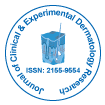Citation:
Ginsburg I, Koren E. A Novel Approach That May Explain the Role of Staphylococcus aureus, Polycations, Neutrophils Pro-Inflammatory Agonists and the Bacteriolysis and Auto Immune Phenomena as Possible Major Events in the Pathogenesis of Atopic Dermatitis: A Working Hypothesis. Journal of Clinical & Experimental Dermatology Research [Internet]. 2019;10 (5).
| 2155-9554-10-508_copy.pdf | 8.84 MB |

Abstract:
The aim of the present short communication is to shed a novel light on the auto immune disorder atopic dermatitis by discussing the possible role played by the plethora of toxic agents released by Staphylococcus aureus which can act in a tight synergism with neutrophils derived cationic polyelectrolytes as related to the pathogenesis of atopic dermatitis (AD) [1,2]. This disorder results in inflammation of the skin characterized by itchiness, red skin, a rash, by the accumulations of large numbers of Staphylococcus aureus their toxins [2] and pro- inflammatory agents secreted by migrating neutrophiles [3], are considered the main cause of AD pathogenicity.

